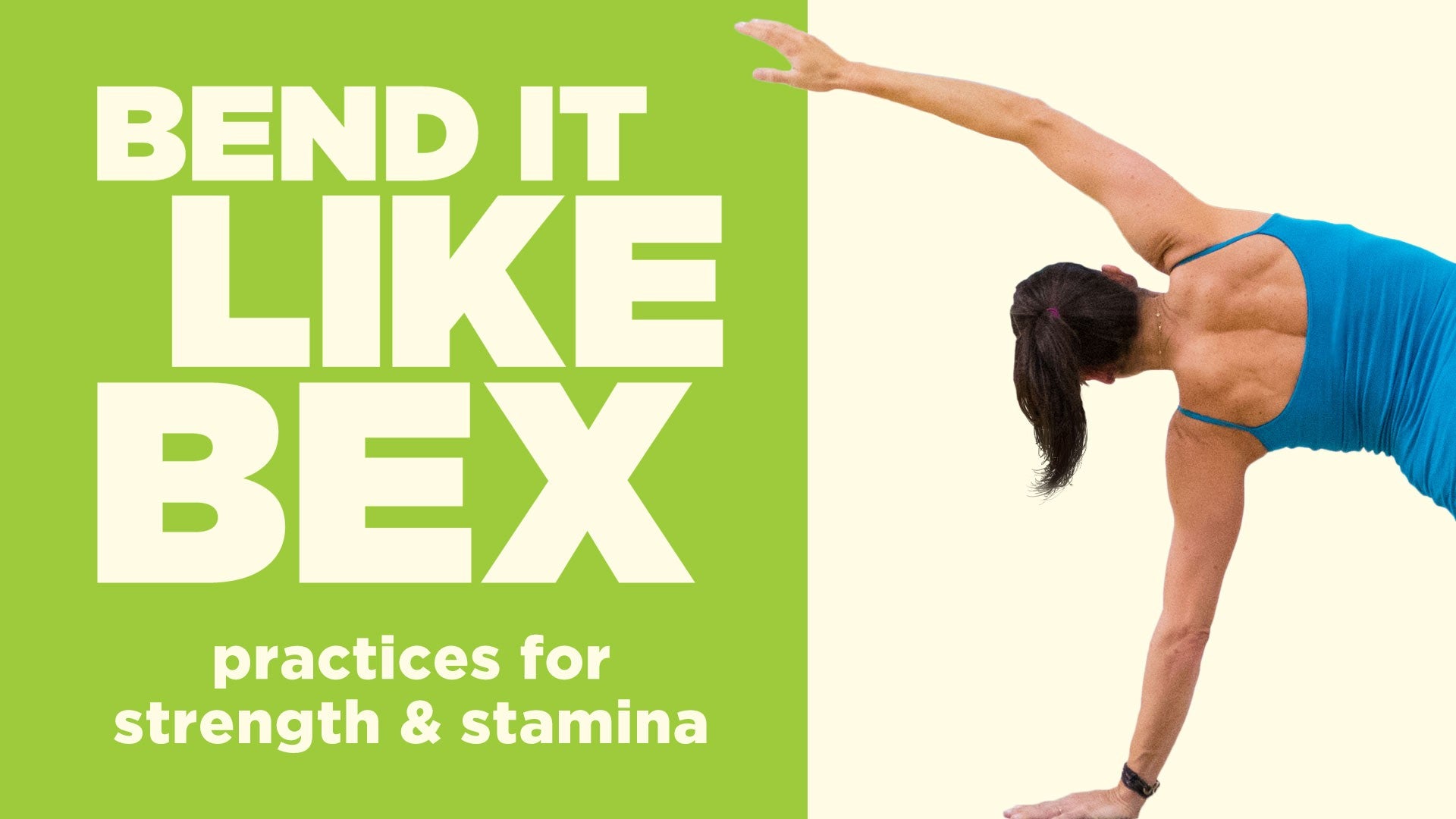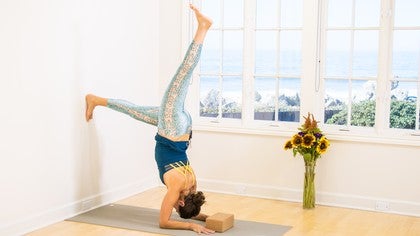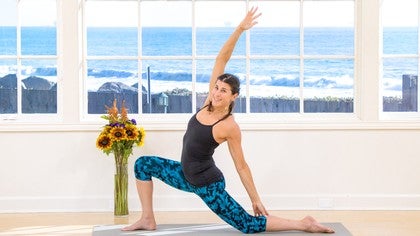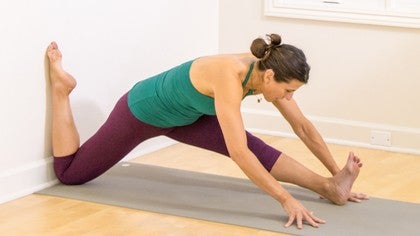Description
About This Video
Transcript
Read Full Transcript
(waves flowing) Welcome, I'm Becks and we'll be doing this sequence with the wall. So find a comfortable spot at home where you have wall behind you. We'll begin with a meditation and I'm actually going to already create a relationship with the wall by sitting and leaning into the wall and feeling the wall lean into me. So we connect. Go ahead and find your comfortable seat.
And if sitting's not comfortable, you can always recline. Your eyes closed, the eyelids sealed, and you get upright. And the beautiful part of working the wall is you can feel where your torso touches and where it doesn't. And it's not something for you to consider, "Oh where should it touch," it just touches where it does. So as you filter the breath in and out through the nose, you align yourself with something bigger.
And so this practice will be about co-creating with the wall. So energetically you might notice where your head lands and see if it's appropriate for you to get more upright or maybe even more width in your collarbones. Alright that width in the collarbones, that horizontal line through body is said to be the wisdom of the universe. So you can delve into the spaces and feel what happens with each unique breath. (breathing) So you let the current of the breath give you more of a sense of reaching up through your central axis, through your spine and simultaneously grounding down.
(inhaling) (exhaling) You may even notice where the mind is right now, where the thoughts are focused. And see if you can widen your perspective to energetically breathing your way in and breathing your way out so the sensations override all of the thinking. (breathing) So it is a brief sit and yet it gives you a platform for spaciousness and a moment to just wipe the slate clean and release any story you were telling yourself before practice. And update your contract with yourself to just be clear and open, clear and open, clear and open. With that you bring your hands to your heart center in prayer.
Maybe that becomes your intentions, clear and open. Or you pick a different mantra, motivation, a dedication to someone, place, an animal. And then the chin bows to the chest. And you open your eyes. So the mat placed connected to the wall, you'll come into Downward-Facing Dog with the heels up just about two inches.
If your wall has a baseboard, that's a great guideline. If not, you can just imagine you're wearing heels or pumps, right just a little lift. And you can bend one knee and the other. It really energizes the legs to come into Adho Mukha Shvanasana in Downward-Facing Dog with the wall. And right away the arms feel something.
A sensation that is different than not having the points of contact to the walls. So you just take a moment to appreciate that. And then release through the neck and feel the mount of the thumb, index, and the middle finger turn on the chest. Alright, the ring finger and the baby finger connects you to the side body. This is a great place actually to feel the pelvis accelerating away from the rib cage and sit bones lengthening up to where that wall behind you meets the ceiling, that little crease.
Slowly slide the feet back so now the toes have a bit of pressure and the heels connect with the wall and inhale to the Plank. And right here you might have to futz with your stance a little bit and lean left and lean right and note the way the legs are super strong here. So the pillars of the arms and the legs get to work evenly. And then slowly lower all the way down. So when you come down you roll the thigh bones in.
I like to just kind of wriggle a bit here. Snuggle the shoulders up to the ears. Press the tops of the feet into the floor and inhale lift for Low Cobra. So the center of the chest kind of pulls through the gate of the arms and then gently release. Note that you could move into Child's Pose now and you can take it at any time in the practice, otherwise right back to Down Dog.
Check out the toes there, and then breathe in through the nose, out through the nose, in through the nose, out through the nose. (inhaling) (exhaling) Slide the toes back once again. And then you'll find that little happy place and come into the Plank. So the mid-line energy is crucial here. Alright you could be on the periphery, you could feel the skin, see if you can hug in a little bit more though so there's that telescoping feeling and then there's no rush.
And you slowly lower all the way down. Once again, you feel the tops of the feet and I need to slide forward for my legs to have space. And then as you inhale this time, see if you can feel the palms of the hands kind of slide toward the wall and the elbows narrow in. That gives you width in the collarbones and then an exhalation will release you. Downward-Facing Dog, and while this practice takes a lot of vigor, I always notice, you know what?
The heart of yoga is the restorative practice, therapeutic practice, and every practice hopefully feels like it incorporates that. That doesn't mean it's always easy though. (breathing) Turn your left heel in, it will meet the wall and the floor and step your right foot forward for Warrior I. So the energy in the back leg really strong here and you will inhale your arms up. And as the arms come up and you settle in to the pelvis, I find that this Warrior I gives so much love to the back leg and the contents of the left side of the pelvis.
So it kind of releases any congestion there. The hands will come down, the right foot will go back. You'll find that Plank with the wall feeling real strong here. You can take Chaturanga to Low Cobra or up. However it feels good and right for you.
And the right heel will come to that same spot wall and floor, left foot will step. Inhaling the arms so the outer seam of both feet really sealed and then you reach up and you just breathe here and you can feel the breath moving through the body and sort of giving you that space to allow the right ribs to move forward in the direction of the top of the mat. Hands come down and again you can always skip this step, Child's Pose or go into Plank to Down Dog. Chaturanga, Low Cobra up, inhaling and then exhale. Now you just wait in Down Dog, you breathe.
And so there's a little bit of refinement. I like to look every once in a while at my inner eyes of my elbows and make sure they're gazing at the opposite thumb. The bony rhythm of the legs working for me. And then just marinating in the broth. Again the left heel in, right foot steps, and you inhale the arms up.
It's also great to notice that with the feet back, with the wall sometimes you can take less of a huge stance in Warrior I and you can feel the vertical line from the shin bones, horizontal line from the thigh bone and it's really clear and that helps you employ the legs. And then the arms come down and again it's a Vinyasa linking of poses with Chaturanga or it's an immediate Child's Pose. Left foot steps, right heel in, arms come up. Sometimes the leg needs a little assistance, my did that time and then you just breathe. And you work to find the nuances like the spaces.
I just became very aware of the outer part of my back shin. Right and how important it is to integrate that into this pose. And then my head was pecking forward. So just check in with those spaces where you can refine. Arms come down and cycle through, breathing in for the Plank, breathing in out for Chaturanga.
Inhale for Urdhva Mukha and then exhale. And you just feel. (breathing) So you do the best you can to remove any sense of struggle. Left heel will turn in, now the outer blade of the left foot will hit the wall and you'll come into Warrior II. So Warrior II and you're using the outer blade of the foot to go there and lifting the inner arches.
And I like that space where you lift the inner arch and they dome 'cause that's that sense of coming in to your core. And the left hand presses into the wall and the right arm is horizontal and it goes and reaches and you look over the right shoulder. If you prefer to look to the left or back, that's fine too. And then you just maintain the pose with a joyful sense right, so a sense of play and also it's kind of nice you have this friend that you're leaning into, that's leaning into you and that's the wall. (breathing) Slowly, gently you'll slide the left hand down until it meets wherever it meets on that outer side of the left leg.
And you'll look down and sit a little deeper into that right thigh if it's possible. And then if you like to look up you can bring the Drishti, the focal point up and breathe here. Inhale come up, cartwheel the arms forward and down, it's one long juicy exhale for Chaturanga. Inhale up, exhale back. Step the left foot forward as the right outer edge connects.
And in that space there's just the right amount of width for the feet, the palm presses into the wall, and the left palm is facing the floor. So when the shoulders recline down the back and the upper traps release, there's also a great sense of recruitment. (breathing) From Virabhadrasana B, you look down and you reverse. Some people like to call this the Peaceful Warrior Hero so how can you embody that? Alright how can you take the edge of the pose and feel and then feel how the energy rebounds into you.
Not overdoing. Inhaling arms up, so moon forward, cycle through one exhale, inhale, exhale, always have the option inside. Always know you can take Child's Pose. Now right foot steps, left heel in, outer blade connects. This time Warrior II becomes your transition.
So you are in Warrior II, you feel the wall behind you. Straighten the front leg, as you straighten the front leg, if you need to shorten the stance it's the front foot coming back in so you keep that grounded point of connection lifting that right knee up so fully alert and engaged through the right upper front of the leg of the quads. And then the hand comes down and as you do this you can look up, down or to the side. And remember there's no point being a greedy grabber, right? Grabbing your toes just feels like grabbing your toe.
If you lose that sense of five lines of energy, of engagement, of knees being sloppy, you just back off. (inhaling) (exhaling) Inhale come up, through Warrior II and then come into Utthita Parsvakonasana. Forearm to thigh, palm facing up, left arm reaches over. You can take it straight up if that feels more appropriate for your shoulder or behind you. And again the opening that you create is for your breath, for your organs and just to steady yourself so that ease outweighs the efforts.
(steady deep breathing) Both hands come down, Plank, Chaturanga, exhale, inhale up, exhale back. So it's a slow and a steady pace. And the purpose behind that is that your legs they want to embody strength and your arms want to feel like they work with your legs. So right heel in, left foot steps, Warrior II, straighten. Again if there needs to be some shoring up of the stance, it comes from the front foot.
You inhale and then slide into it. And as you slide in, feel for the little bit of slurping of that left thigh bone into the pelvis and then breathe. Alright so the features of the face, very soft, very lively and free. And then you keep staying with precision. As you exit Trikonasan you inhale up through Virabhadrasana B and then forearm to thigh.
Parsvakonasana, a long side angle. So any variation that you feel like is bringing you into a space of healing, right? If looking down supports that, to the side or up. Sometimes I notice in my body I'm yanking at my neck and I have to just like back up, back up and breathe. Maybe my mind think that it's better if I turn my head and my heart comes in and says just breathe and open up and then I get natural adjustments.
(breathing) Excellent then both hands come down, Plank and you move through exhaling, inhaling,, exhaling. Left heel in, right foot Warrior II, you know what's coming, Ardha Chandrasana, how could we not. So I like to slide to the right foot in just a little bit because I know I have a legs distance from the wall. And if I can slide the foot in and then just trust when the right hand comes down, maybe I have that distance that's a leg distance. And if you don't you just futz around with it.
You make it as graceful as you can and this is just a wonderful place, right? The legs are happy, the arms are happy, the torso is happy. Breathing, and I'm just going inward, inward. Right not comparing to any practice, any other day. Not comparing to any other practitioner, just being in that space where I'm like, "Oh this feels pretty good." Then slowly, little micro-bend in the right knee, left hand down, left leg back, right leg back.
And this time I use Down Dog to clear my legs. To charge them right, and to fee like wow that's amazing. At least that's how it feels to me. And that's my wish for you too, inhale, Plank, exhale, Chaturanga, inhale, low cobra up, exhale down. So my left side is pretty excited.
I have to just like reign it in and hold in Down Dog for a second. Left foot steps, right heel in, outer blade connected. So there's that moment landing in Warrior II and then sliding it in and breathing and transitioning. Right and this side I just have to get my ground on the wall right, so the wall now is a grounding point. And in that point of contact, so there's so much strength that I could remove my left hand.
And I would only do that if it really felt like I had the support right, because it doesn't prove anything to me. And then the right ribs are eager to kind of roll back so that the whole front line of my right leg can feel cohesive length. Alright we want to avoid overdoing in yoga otherwise the after-taste is potent for a few days. Hands on the right down, right heel lands, and then left leg, Down Dog. Inhale, Plank, always optional, exhale, Chaturanga, inhale Low Cobra up, exhale, Down Dog.
Turn that left heel in and you'll step into Warrior I and if that sounds like I'm confusing you, I'm not. We're going into Warrior I, after Warrior II I always feel a little rebellious when I do that. So you sit deep into it and you're like, "Ooh yeah," and you breathe. And from this space you see can the weight of the arms feel buoyant as there's like a descending sensation in the pelvis. And then you inhale, straighten the front leg.
So for Parivrtta Trikonasana, the revolved, you're gonna slide, you will slide the right heel in and the left foot will cut a little bit more forward, the left foot will cut a little bit more forward. And I use my right hand to guide my right hip back. Now, the left hand goes under the left shoulder, that's the first step and then I notice ooh I've lost that contact with my back heel so I slide. 'Cause that's part of the sensation I want to feel. And then if it feels appropriate and available, you can move the hand on top of or outside.
And this is where if you know you need a block, you could integrate that. Now you might stay here looking down, lot of leg work, it feels like my legs are scissoring close towards each other or you might find that the arm rises. And if the arm rises, you'll note the way the balance is being challenged. And that's kind of fun so it see it as fun. In you're body, oh there's a place in my right outer hip that goes oh yeah, come here.
And then a little tethering of the navel. And then very slowly, bend the right knee. Now approximately a leg's distance and you're just gonna have to trust that you're a legs distance, and if you are, great, if you're not, like I have to creep my foot a little bit. Stay with a bent right knee, fire up that left leg and then bring the arms back for Dekasana Airplane, right, and sometimes takeoff isn't as smooth as you'd like it to be. There's a little Up Dog, the outer part of my right leg is feeling this.
And then the hands come down, left heel lands, right heel lands, and you breathe. If you want to Vinyasa, you take it. I'm imagining my Vinyasa and it feels so great that way right now, it was a beautiful Up Dog I just did. Now the left foot steps, right heel in, come into Warrior I again and get that sensation that there is the Earth energy coming up in through the bones and then feel that inspire you to lift and breathe. (steady deep breathing) Straighten the left leg, again the front foot moves toward the wall and then I just self-adjust.
I gently nudge my left back and my right hip forward. And then there's like a little bit of effervescence through the center line, heart center. Hinging forward, right hand down, right never forcing here. Maybe right hand top, maybe outside, I love that feeling of my left thumb in the front crease of the hip. And then reach the left arm up if it's available.
Not available, not a big deal. Right the breath will tell you what's available. And what I mean by that is, if you have to hold your breath or if you feel like you're bearing down, it's not worth it. Your best expression of you. So now hands down, again you're counting on that left foot to ground you, the right leg goes into the wall.
I notice I need to step, you know an inch or two forward and really straight through the leg in the air, a little bend in the knee so that that feeling of taking off is seamless, breathe, little bit of that current of a wave up. Hands down, right heel lands, left heel lands, breathe, Child's Pose and you maybe thought it wasn't gonna happen but you've always had that option, right? Permission to take it at any time. So I come into it. Landing here feels excellent.
(breathing) And then slowly I come up, you don't want to stay there too long otherwise you think it's Shavasana time and it's not yet. So come onto your forearms, and find that magic distance from the wall where your legs feel super jazzed about this and you just hold here. And as you hold here, there is this sense that the front body and the back body gather together, side body as well. And then very slowly you will walk the elbows in just to feel that dolphin shape. And you'll breathe.
(breathing) And then you'll land you're knees and you'll sit on you're heels. So you'll take your block right now or whatever prop you have, your water bottle, whatever it is. And you will use it to measure the leg's distance away from the wall. I use it to measure and I also like it in between my hands so that my shoulders feel supported. So I take my leg's distance and I will say that right here my leg's distance feels like not a big deal.
But when I flip over, I know that something is going to feel like it's happening. So right where my hips are, I put the block there and then I know that's where my elbows with be, okay. So I move the block, I literally am that precise. I move the block, I put it there and then I put my forearms down and I have to remind myself that I am making a square, not a ladder. Right because I've seen it many a time and just to be kind to you, I'll show you the difference.
So you come in and now that I know my elbow's in the right place I'm going to move the block so my hands can use the block. And I will slowly walk up the wall until I feel like my thighs are parallel to the floor, and my ribs are in. Now many of you will walk up here and feel like this is so great. If you could hold Forearm Plank like this without your feet on the wall, I would be really impressed. But I know that it has to be in that square.
And then you slowly come down. So you come down and you feel that. We're going to go up one more time. When you feel that place where it actually feels like your bum is too far over your shoulders, that's where the magic happens, okay? So again, you go forward and this time you just, it's an offer, the pose is an offer, and an offering.
So you just sit with that, there's no where to get to in the pose, wherever you are is exactly where you need to be today, okay? So the right foot up, left foot up. And then if you're inspired you can lift one leg. Right if that really excites you, you can bend and lift the other one. And then slowly come down, remember exiting gracefully is crucial, and come into Child's Pose.
(deep breathing) So those were just a warm-up, they were a warm-up to get your soldiers to say, "Hey are you ready for the party?" So now what you will do is, measure it out standing for handstand, that being said, if you are not in favor of handstand, you will not do it. You can do another form balance or you can just go right now and put your legs up the wall. Right you're not foraging forward, you're meeting yourself where you are right now. So I will measure a leg's distance but it's really an arm's distance because now, I prefer that and here's where your boom boom has to kind of settle back, right? It has to settle back so you have that length through the torso and again the block can be used to keep you on honest, right?
To keep you honest, oh it needs to be right there. Because I know when I turn around I'm going to think, "Oh I need to be further away from the wall." I'm going to think that every time. Now matter how many times I do it. And I remember I'm not creating a codependent relationship with the wall, like I don't need the wall, it's helping me, it's helping me, okay? So I come with my hands down and say, "Oh thank you wall for being my friend," and then I say, "Oh no I don't want to straighten my legs." And then I do, magically, and I have to coach ribs in and lift a leg.
I don't have to lift a leg, I just might want to. And then I may even want to switch. And I know for me my elbows could be straighter. But they are what they are. I appreciate that they work.
And then slowly I come down. Right and in that moment I land and go "Woo that was a lot." So I just wait for a second. Chew on that. And not in fact I could turn around and do it again, but I've seen it enough times in class where people hesitate so I'm going to give you a little tip that I think will make it more user friendly. So when you turn around, you will land leg's distance and you will use the block to measure off a knee's distance.
And you might think why, because when you know you're a knee's distance when you flip, you're close enough to the wall where if your feet hit, you can be your own best assistance, okay? So my hands now are going to land like my feet normally land during the day. I do have that moment where I get brave and I have to have that courage for my heart. And I breathe and if you don't feel like you have it today, you just go back and put your legs up the wall. Otherwise you walk forward, shoulders want to hover slightly ahead of the rest and then you kick up.
Of course today I can't get to the wall, there it is. Okay so now I get to the wall, I bend my knees, and I use that platform on my feet to correct my ribs, which are ever so naughty and then one leg and the other. And then I just play with maybe my head could go forward and my ribs could come in and then I land. And then I kneel and then I breathe. Now there's a temptation to want to do it again and again.
Today I'm going to be at peace with one. So if you want to do it again and again, you go and you do that, for me I feel like, woo I was flipping that a lot, I'm okay. And what I will do now is take a juicy Forward Fold. So what is that, now I know my friend the wall's not gonna move so I walk in as close as I can and I know it's gonna catch me. And then in a moment I assist my legs and I keep folding and I assist my legs and I fold.
Some people like the arms on the inside. I just like knowing that my arms are weightless, my head is weightless, and I'm hanging here with my buddy the wall who just keeps holding me. Alright so the hands can go behind, they can go in front. I'm just sort of draining out. Alright, letting go or releasing.
Knowing that the practice bubbled up, it made me feel that fountain of energy and now I'm releasing anything that's not serving. (deep steady breathing) 'Kay so when you come out, it can be a little disorienting. So just listen, walk back a little and then let your knees land, trust me on this, take Child's Pose. Alright so you let your head land because sometimes having your head below your heart can take you into a space that's just a little bit upside down. Then you'll slowly sit up and take your legs up the wall.
Okay so I'm just gonna put my legs up the wall, if you want to put a block underneath your sacrum, you know your block is right there. If you Viparita Karani you could do that. I just like, go ah, see now the wall we're friends and I'm gonna take a couple of breaths here to close my eyes and just re-arrive. So if this feels really nourishing for you and you just want to stay, you can stay here as long as you like. And you can feel that return of energy from the feet.
Right, all day long you're on those feet so this is a place you would find me after a long day of walking, always. Just lying on my back and letting my legs release some of the flow. If you're ready for a gentle twist, you'll carefully wriggle just slightly away from the wall like a knee's distance again and you pick the hips up, move them left and just slide the feet along the wall, and let the legs land. It's kind of sweet for me on this side because the block is there so it's receiving my ankles. And I just breathe and look over the left shoulder.
(breathing) And then come back through center with the feet, remember you moved the hips to the left, so now you'll pick the pelvis up and move it to the right and the knees will go down. And the gaze is going to be over the left shoulder or the right. I like to just gently rub the right outer thigh. (breathing) Come up through center and roll onto the right side here, up to seated, and use the wall again, so sit and lean into the wall and feel how the wall leans into you. And then you kind of find that place where you merge together, clear and strong in that space where you've co-created something very magical.
Hands come to the heart center in prayer, exhale the breath out, inhale. (exhaling a tone) Clear and strong and sweet. Namaste.
Bend It Like Bex
Comments
You need to be a subscriber to post a comment.
Please Log In or Create an Account to start your free trial.












